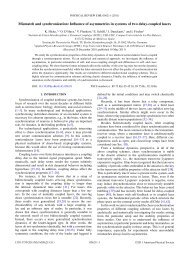DBI Analysis of Open String Bound States on Non-compact D-branes
DBI Analysis of Open String Bound States on Non-compact D-branes
DBI Analysis of Open String Bound States on Non-compact D-branes
You also want an ePaper? Increase the reach of your titles
YUMPU automatically turns print PDFs into web optimized ePapers that Google loves.
CHAPTER 2. BOSONIC STRINGS 28This algebra can be derived by using the commutati<strong>on</strong> relati<strong>on</strong>s for the expansi<strong>on</strong> modesexpressed in Eqs. 2.49 - 2.51. Quantum mechanically, things get a bit messier because<str<strong>on</strong>g>of</str<strong>on</strong>g> the earlier noted ordering ambiguity, and the algebra becomes[L m , L n ] = (m − n)L m+n + c12 m( m 2 − 1 ) δ m+n . (2.96)The derivati<strong>on</strong> <str<strong>on</strong>g>of</str<strong>on</strong>g> this result is somewhat tricky, and can be found in full glory in e.g.the Appendix to Chapter 3, p. 54-55 in [14], or via an alternative approach in [9], p.80-81.As is usual in quantum theories, we will order our operators using the normalorderingc<strong>on</strong>venti<strong>on</strong> <str<strong>on</strong>g>of</str<strong>on</strong>g> “lowering operators to the right and raising operators to theleft,” resulting inL m = 1 2+∞∑n=−∞: α m−n · α n : . (2.97)We should be careful though. Since we find ourselves in the beloved and charmingpresence <str<strong>on</strong>g>of</str<strong>on</strong>g> gravity (<strong>on</strong> the world sheet), we can no l<strong>on</strong>ger ignore the extra c<strong>on</strong>stant thatresults from the normal ordering prescripti<strong>on</strong> as we did in the case <str<strong>on</strong>g>of</str<strong>on</strong>g> QFT. However,since all operators commute except those c<strong>on</strong>stituting L 0 , this ordering ambiguity is<strong>on</strong>ly relevant for L 0 , and we take this into account by replacing L 0 by (L 0 − a) wheneverneeded, where a represents the as-<str<strong>on</strong>g>of</str<strong>on</strong>g>-yet undetermined ordering c<strong>on</strong>stant. 6This c<strong>on</strong>stant also has repercussi<strong>on</strong>s for the mass <str<strong>on</strong>g>of</str<strong>on</strong>g> states. We demand that for aphysical state |φ〉L m |φ〉 = ˜L m |φ〉 = 0 m > 0, (2.98))(L 0 − a) |φ〉 =(˜L0 − a |φ〉 = 0. (2.99)The sec<strong>on</strong>d c<strong>on</strong>diti<strong>on</strong> is simply the mass-shell c<strong>on</strong>diti<strong>on</strong>. The first c<strong>on</strong>diti<strong>on</strong> can be understoodas the quantum translati<strong>on</strong> <str<strong>on</strong>g>of</str<strong>on</strong>g> the classical vanishing <str<strong>on</strong>g>of</str<strong>on</strong>g> the energy-momentumtensor T αβ . Quantum mechanically, our first guess would be to impose thatT αβ |φ〉 = 0, (2.100)however this would imply that all operators annihilate physical states. This would leaveus a little embarassed, as little physics would survive. The next best thing we can do isdemand that〈φ|T αβ |φ〉 = 0. (2.101)Remembering that in the mean time we normal-ordered our Virasoro generators, we seethat this time around the lowering operators can destroy |φ〉, while the raising operatorscan destroy 〈φ|, which leaves a fully c<strong>on</strong>sistent spectrum <str<strong>on</strong>g>of</str<strong>on</strong>g> physical states. This isanalogous to the statement expressed in Eq. 2.98.6 Basically, we are simply rewriting L 0 = `12P: α −n · α n : +a´ as L 0 − a = 1 2P: α −n · α n :.
















